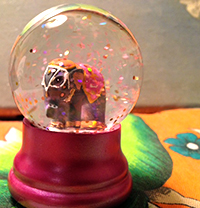Bring an Emotion to Work

This year, the Townsend Blog will feature a series of posts from members of its Working Groups. The "History of Emotions" Working Group brings together students and faculty whose research could be enriched through further knowledge of the field of emotions and its historiographic methods. In this post, Padma Maitland, coordinator of the working group, discusses the group's recent "Bring an Emotion to Work Day."
Recently, there has been a move in scholarship to consider emotions as objects for historical inquiry. Looking beyond mere affect, the history of emotions tries to consider how a study of emotions can help deepen and refine our understanding of the past. But what is the relationship between objects and emotions? Emotions can become intimately attached to objects, animating them with our emotional engagement or triggering emotional responses. The distinction between objects and emotions as instigators of feelings or perceptions is not always clear; they often take turns grounding a particular experience or perception of the other.
The History of Emotions Working Group at Berkeley chose to begin the year with an experiment that we call “Bring an Emotion to Work Day.” This experiment seeks to confuse the boundaries between objects and emotions, suggesting that the objectivity of things and the subjectivity of emotions can sometimes become blurred in the immediacy of experience and the lingering power of nostalgic remembering. For our first event, held on September 12th, we asked everyone to bring in an item—an object, artifact, quote, or image—that they perceived to be somehow latent with emotion. We then discussed each object, trying to think of all the ways that the emotional valences of the object could begin new lines of inquiry that question or resituate the object within a given discourse.

"The Menaced Assassin," René Magritte, 1927.
Among the objects on the table for discussion were the “cheerfulness” of the Blau-Gold- Haus in Cologne, the gramophone from René Magritte’s painting “The Menaced Assassin,” an image of India as the Goddess Kali mutilating herself on the cover of Time Magazine from 1947, and a small elephant snow globe. Discussing Magritte’s painting, we focused the object of the gramophone. Unlike the dead body on the bed behind him, the gramophone is active. It animates the scene and heightens the emotional registers of the painting. At odds with the macabre aspects of the image, the gramophone is disturbing, becoming a focal point for the narratives used to understand the image.
Continuing our discussion of how objects stir memories or are brought to life by them, we focused on the elephant snow globe, the kind of object usually associated with children. Referring to Susan Stewart’s On Longing: Narratives of the Miniature, the Gigantic, the Souvenir, the Collection, we considered how, for children, the world comes to life through daydreams. Through these daydreams, a small toy might be able to “move” for them. As adults, our own experiences suggest a different engagement with things. The object is less animated; it doesn’t, for instance, walk around the room for us. Instead, the object serves as an anchor to an active process of remembering and imagining.
For our own studies, though, the question is, “how can objects carry different sentiments and translate them across time and to new places?” It is one thing to have a personal engagement with an object, but what does it mean for there to be a cultural engagement? The gramophone, surreal and technological, represents a certain history of art and innovation, all of which impacts the emotional readings of it in the space of the painting. The elephant has a long history in art, culture, religion, science, and politics. Painted and put in a small snow globe that showers it with glitter, the cultural legacy of the elephant merges with the kitschy tradition of knickknacks. Perhaps in considering new social engagements with animals and the empathetic readings that elephants seem so prone to elicit, we might be able to trace the history of cultural exchanges and power dynamics that led to the elephant snow globe’s creation and its placement within a Pier One Imports store.
“Bring an Emotion to Work Day” is an ongoing project to which we will continue to return over the course of the year. A growing selection of objects and emotions are currently featured on the History of Emotions Working Group website.
On October 4th and 5th there will be a related conference, Object Emotions: An Interdisciplinary Conference, in 341 Dwinelle Hall. Sponsored by the Townsend Center and the Departments of Architecture and English, the event will feature panels on topics ranging from object migration, replicas and fakes to intimacy, animated objects, and feelings and commodities. A roundtable discussion on the 4th will consider the ways in which different professors within the humanities at Berkeley have begun to incorporate objects and emotions in their own work, as well as the potential limits of such work.
And on January 23, 2014, we are planning a global “Bring an Emotion to Work Day,” during which we ask scholars from around the world to join us for a lively discussion of objects and emotions. For more information or ways to get involved, please email us.
Image Credits:
Snowglobe image courtesy of Padma Maitland
The Menaced Assassin by René Magritte courtesy of MOMA